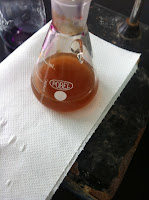Aim:
To
investigate the amount of hydrogen peroxide in commercial oxygenated water.
Background information:
A
titration is a reaction of a solution of unknown concentration with a solution
of a known concentration for the purpose of finding out more about the unknown
solution. So, redox titrations are very used techniques for knowing the
concentration of a solution in a substance.
Commercial
oxygenated water is a solution of hydrogen peroxide in distilled water with a
variable concentration between 3 and 30 %. This concentration is often used in
term of volumes.
Materials:
- Stand and clamp
- Burette
- Erlenmeyer
- Pipette
- 100 mL volumetric flask
- Potassium permanganate ( KMnO4) 0.05 M
- Commercial oxygenated water
- Sulfuric acid 2 M
Procedure:
- Arrange the burette in the stand with the clamp. Fill the burette with the potassium permanganate solution until level 0, be careful to not leave bubbles in the burette.
- Make a solution of commercial oxygenated water taking 10 mL of it and pouring into a 100 mL volumetric flask with distilled water.
- Take 25 mL of this solution using the pipette and pour it in the erlenmeyer, then, add 25 mL of 2 M sulphuric acid and 25 mL of distilled water
- Titrate the mix (pour the mix) with the potassium permanganate solution until a slightly violet colour appears in the erlenmeyer.
- Write down the volume needed and repeat the whole process again to verify the result.
- Calculate the hydrogen peroxide concentration of the commercial oxygenated water and compare the result with the one on the commercial bottle.

Bibliography:



No hay comentarios:
Publicar un comentario